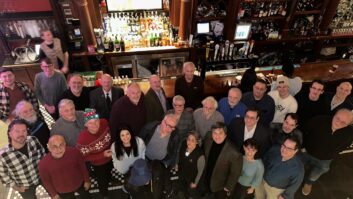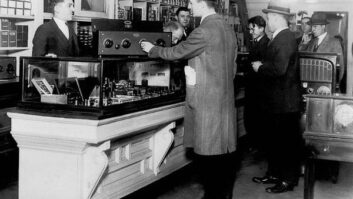As an Active Year for Digital Radio Comes to a Close, Here’s a View of HD-Radio’s Ups And Downs
The past year certainly was a tumultuous one for digital radio. Here’s how this observer rates the performance of progress toward transition for the period just ended. It’s a classic case of good news/bad news.
In September, Ibiquity announced that its PAC codec would be replaced with a new proprietary codec called HDC, and by all accounts its performance is improved over PAC’s at all bit rates. No actual subjective test results have been provided, however, so this conclusion is so far based on hearsay from listeners who were carefully selected by Ibiquity (I was not among them) .
Nevertheless, many of these listeners are widely trusted names in the industry, and their results are highly corroborated. This announcement ended the hiatus on standardization work that the National Radio Systems Committee had imposed due to dissatisfaction with the PAC performance at bit rates below 96 kbps.
The path to data broadcasting, Ibiquity style, also was initiated in mid-year, as the company released some basic documentation on how it foresees data and applications being incorporated into the HD Radio format.
Dual antenna testing also presented positive results. Within certain guidelines – which are strict but not untenable – this option may reduce implementation costs significantly for some FM stations. After some additional work is completed, rule changes will need to be made; they are not expected to encounter strong opposition.
Meanwhile, tests of the Tomorrow Radio project seem to be showing a good outcome. Much of the detailed data is still being processed, but initial results show favorable performance for supplemental, digital-only audio service(s) on FM-IBOC, with coverage that largely duplicates Grade A analog contours. Project principals from NPR, Kenwood and Harris all report that Ibiquity staff was helpful and supportive in these tests.
On the receiver side, Kenwood has begun shipping its first HD Radio receivers in small quantities, and the first OEMs have announced Ibiquity’s certification of their components, meaning that high-volume production likely will begin in mid-2004.
Now the bad news
Although the NRSC’s suspension of its standardization work officially ended in September, the IBOC Standards Development Working Group (ISDWG) has held only one meeting since, and no additional progress toward a standard has been made since the hiatus was initially called in May 2003. The codec flap at the ISDWG immediately was replaced by a conflict over intellectual property disclosure and general openness of the HD Radio system (particularly on its new and still proprietary audio codec, as well as its datacasting architecture).
Although there has reportedly been some progress in subsequent discussions between Ibiquity and the NRSC, the standardization process remains at a standstill. While 2003 saw significant movement for HD Radio in several areas, standards development is not among them.
It is difficult to assess the practical consequences of this problem, but it is likely that at least some receiver manufacturers will remain uncommitted to HD Radio until it is settled. Also, the FCC probably will not move beyond interim rules on digital radio until the standard is completed.
The unusual regulatory process that the FCC embarked upon in 2003 for the digital radio transition also may remain a source of difficulty in years to come. While the commission attempted to stimulate the industry and be responsive to early adopters and developers, this proactive stance potentially has allowed a train to emerge from the station without sufficient speed to make it over the first hill.
The precedent set by putting a federally regulated industry’s transition largely into the hands of a single commercial enterprise may ultimately be judged as prescient and groundbreaking, or naive and foolhardy. Final rules have yet to be set, of course, and much could be changed in the interim, so such judgment will remain premature for some time. Whichever opinion predominates, however, it will have fundamental regulatory resonance for many future proceedings, akin to the AM stereo case.
Meanwhile, deployment continues, but the number of stations and receiver manufacturers committed to the format is still indicative of a lukewarm industry commitment to date. It is still early in the game; but a stronger vote of confidence would certainly be welcomed by HD Radio supporters at this point. Receiver manufacturers’ commitments to date are also smaller than proponents would like to see, but this may change substantially in 2004 if momentum builds.
In contrast, uptake for satellite radio seems to be rapidly strengthening, as the first wave of factory-installed receivers hits the market. Near year’s end, XM Satellite Radio announced it had reached 1 million subscribers, and the publicly traded company’s stock showed more than a 1,000 percent increase during 2003.
Ironically, satellite radio’s success eventually may turn to an advantage for HD Radio, as devices that combine XM and/or Sirius receivers with HD Radio tuners emerge in upcoming years, and HD Radio rides the coattails of demand for new satellite radios into consumers’ cars and homes.
As another measure of comparison, Eureka-147 DAB receivers in Canada and Europe are showing some signs of life, as prices drop to broadly affordable levels. Although the DAB story is still a mixed bag from country to country, the regions showing the most success are, not surprisingly to readers of this column, those where new services available only via DAB are offered, such as the United Kingdom. Spurred by the snowball of increased demand, these are also the same regions where receiver prices are lowest. The mantra of this column continues to be proven: “Quantitative, not qualitative, change drives the mainstream market toward adoption of new services.”
Finally, although Ibiquity’s engineering staff has been effective in producing much of the good news noted above, the company has lost some key and veteran staff in 2003, ostensibly due to downsizing. Most notable was the departure of Glynn Walden, officially called a resignation but widely believed to be a RIF. His absence has left a void, and it will likely be long felt.
Split decision
So while it now seems nearly certain that HD Radio will reach some sort of fruition in the U.S. radio industry, there are still a few lurking issues that could slow its adoption or even derail it. Although the outlook is more stable and upbeat than it was last year at this time, HD Radio’s prospects and timeframe for wide-scale adoption by consumers are still anyone’s guess. Meanwhile, deployment continues, albeit quite cautiously, with the likely additional option of dual-antenna installation ahead, and a potentially improved ROI thanks to the Tomorrow Radio project. Receiver availability and penetration will be key issues to watch in the coming year.
Clearly it’s been a mixed year for HD Radio, with high marks for engineering developments, but less stellar results for business issues. An optimistic assessment might consider any forward movement as positive, given the length of the process vs. its progress to date. Nevertheless, a more balanced approach is needed in 2004 and beyond if this transition is to be ultimately successful.












